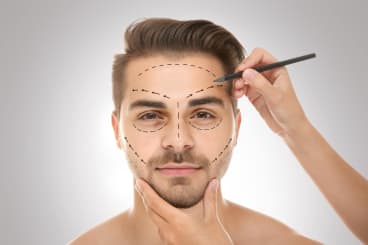 Kybella®
Kybella®The Skinny On Buccal Fat Removal
Buccal fat removal might be the hottest cosmetic procedure you've never heard of. Here's everything you need to know about the high-impact procedure from plastic surgeons Dr. Benjamin Paul and Dr. Jacob Unger, as well as real patients.
Buccal fat removal might be the hottest cosmetic procedure you’ve never heard of. Plastic surgeons have been performing it for decades, usually in conjunction with other facial surgery, but this relatively simple procedure alone is gaining in popularity for its potentially dramatic impact. Buccal fat surgery involves removing, through a small incision, all or part of the buccal fat pad, which is located below each cheekbone in between the buccinator muscle (which aids in chewing) and several other facial muscles. In the right candidate, the result is a slimmer midface, the surgical equivalent of very slightly sucking in your cheeks for a selfie.
This type of cheek reduction surgery is becoming more widespread, says New York City-based board certified plastic surgeon Benjamin Paul, MD, “because the procedure is becoming better exposed; Instagram and our selfie culture has people face-tuning and reviewing their (facial) contours with a fine-tooth comb; and a chiseled look is in.”
While seeking out a surgery seen on social media has become ubiquitous, particularly among millennials, plastic surgeons caution against it. Nashville-based board certified plastic surgeon Jacob Unger, MD, explains that “when executed properly, buccal fat removal gently changes the contour of the face. But it can certainly be over-resected – which means too much fat is removed. Going from a full face to a severely sculpted look is not subtle. We have to recognize that what sells on social media is not necessarily what works in reality.”
Instead of relying on someone else’s sculpted selfie, both doctors encourage people to consult with a board certified plastic surgeon qualified to evaluate each patient’s unique anatomy. Beverly Hills plastic surgeon Andrew Frankel, MD emphasizes that while buccal fat removal “can be dramatic in certain situations, it will not necessarily make a round-faced person have a less round shape.” Dr. Unger elaborates: “Patients who are otherwise fairly thin but have those ‘chipmunk cheeks,’ are ideal candidates,” as well as those whose facial shape has changed with age. “Facial aging is a descent of tissue and a loss of volume. Over time, the upper cheeks descend; our egg shape becomes more square. So buccal fat resection works when done as a conservative removal of excessive fullness in the central and lower cheek, where nobody wants volume.” Which is why Dr. Unger frequently performs buccal fat removal with other facial rejuvenation procedures: “It’s a combination of filling in the valleys and reducing the peaks to create an elegant contour.”
Despite its growing reputation as a “lunchtime tweakment,” buccal fat removal is still surgery, with all of the associated risks, as well as a price tag of around $3,000 to $6,000, depending upon the patient’s facial anatomy and desired goals. All three aesthetic surgeons interviewed perform buccal fat removal alone under local anesthesia, an option that’s trending with younger patients, and under general anesthesia when combining it with other procedures, which is more common in patients seeking facial rejuvenation. In Dr. Frankel’s practice, he tends to perform buccal fat removal in conjunction with submental (under-chin) liposuction and chin augmentation. “Those patients are often looking for a more slim, chiseled appearance and are also younger as a group,” he says. In Dr. Unger’s practice, he frequently combines buccal fat removal with treatments like neck liposuction, facial fat grafting, in-depth facial resurfacing, and minimally-invasive contouring procedures like FaceTite and NeckTite, “to restore the egg shape” of a youthful face.
When performing a buccal fat removal procedure, the plastic surgeon numbs the cheek with a shot of lidocaine, then creates a small incision in the cheek wall at the level where the upper and lower teeth meet. The buccal fat pad, distinct in both color and consistency from the surrounding fat, is “gently teased out of its compartment,” says Dr. Frankel, “then cauterized. The incision is closed with absorbable sutures and the other side is then done.” The procedure generally takes about a half-hour.
After buccal fat pad removal surgery, patients can generally expect minor discomfort and swelling that persists for about a week to ten days – sometimes longer. Dr. Paul advises patients to ice for the first 48 hours to mitigate the swelling, to stick to a soft food diet for a week, and to avoid exercise for 10 days. Typically, patients are able to work from home after a few days, and can return to work (provided it does not involve strenuous activity) in a week. According to Dr. Frankel, “the results become optimal around four to six months.”
Though complications are rare in the hands of an experienced, board certified plastic surgeon, risks associated with buccal fat pad removal surgery include infection, hematoma (blood accumulation), seroma (fluid accumulation), damage to nerves and/or salivary glands, asymmetry, as well as general anesthesia risks (if applicable). “Without proper knowledge and experience this simple procedure can turn into a long, bloody surgery with potential nerve injury or injury to the parotid duct,” Dr. Frankel says.
Beyond these immediate complications, Dr. Frankel warns, improper or unwarranted buccal fat pad removal “can lead to premature facial aging due to volume depletion. Over time a hollowness can develop in the cheeks and the skin can become lax; especially in older persons or those with less elastic skin.” Dr. Unger adds, “Fat is there for a reason – it’s a glide plane.” Fat is necessary, says Dr. Unger, to lubricate the muscles involved in chewing and speaking. “If you’re getting overly sculpted, you could get lots of complications functionally, or you could look strange.” Although there is little recourse for patients experiencing medical complications, Dr. Frankel notes that an overly gaunt appearance “can be rectified by injecting filler back into the cheeks.”
If you’re considering buccal fat pad removal surgery, talk it over with a board certified plastic surgeon who has experience in facial aesthetics. To give you an idea about what to expect before, during, and after buccal fat procedures, The AEDITION spoke with several patients.
After discovering buccal fat removal on the Internet, Tamara* sought the advice of a plastic surgeon to address excess volume in her mid and lower face. “I had full cheeks since I was very young and wanted to know if there was anything I could do about it,” she said. “For me, it was combined with neck liposuction to refine my lower face contour.” Now that her final results are apparent, she “absolutely” would do it again. “I do feel better about myself and my looks, especially in photos,” she says. “I love the improvement in my cheeks. I look thinner and have a better contour. It’s really a subtle but elegant improvement.”
Caroline* also became aware of buccal fat removal surgery through Instagram. “In recent years, I started noticing a lot of those ‘can you guess what she’s had done’ pictures of celebrities and models coming up on my feed. I was intrigued by the idea of being able to achieve some of that incredible bone structure through what seemed like a relatively simple procedure.” After researching and consulting with a local plastic surgeon, however, Caroline received a response she wasn’t expecting. “The surgeon told me that because my face is fairly narrow and thin – I don't have those ‘chubby cheeks’ – I wasn’t a good candidate. He said that I’d be much better off adding volume to my cheekbones with filler or fat than removing it from below the bone and risking being too skeletal as I get older. Although it surprised me at first, I was grateful that he wasn’t just trying to take my money for a procedure that wasn’t right for me.”
Like any other cosmetic surgery procedure, the decision to undergo buccal fat pad removal should be a collaboration between patients and their plastic surgeons. Handled correctly in the appropriate candidate, the surgery is subtle but impactful not only for the cheek area, but the facial contours as a whole. As Dr. Unger observes, “it’s like any type of facial rejuvenation. You look like an improved version of yourself, but no one else should recognize a surgical difference.”
*Patient’s name has been changed.
Related Procedures

AEDIT
‘Try on’ aesthetic procedures and instantly visualize possible results with AEDIT and our patented 3D aesthetic simulator.

